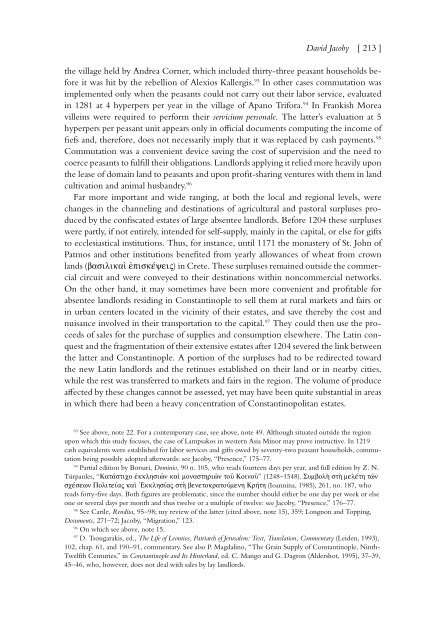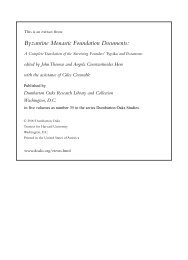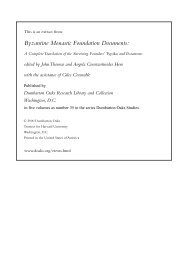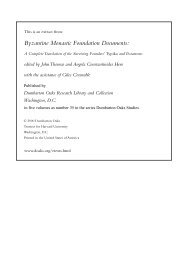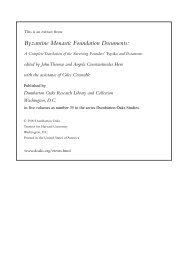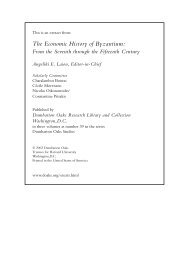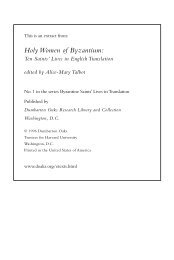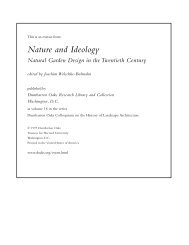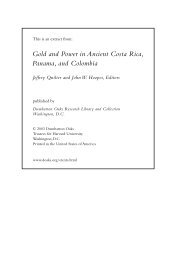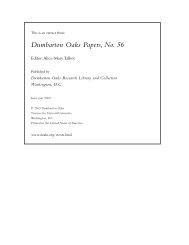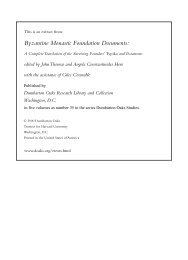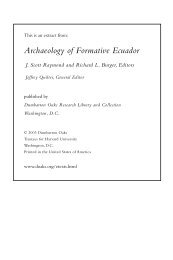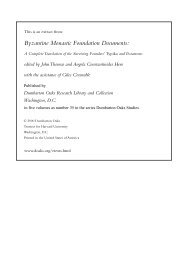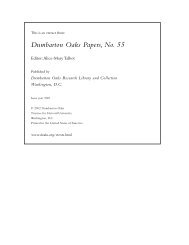Changing Economic Patterns in Latin Romania - Dumbarton Oaks
Changing Economic Patterns in Latin Romania - Dumbarton Oaks
Changing Economic Patterns in Latin Romania - Dumbarton Oaks
Create successful ePaper yourself
Turn your PDF publications into a flip-book with our unique Google optimized e-Paper software.
David Jacoby [ 213 ]<br />
the village held by Andrea Corner, which <strong>in</strong>cluded thirty-three peasant households before<br />
it was hit by the rebellion of Alexios Kallergis. 93 In other cases commutation was<br />
implemented only when the peasants could not carry out their labor service, evaluated<br />
<strong>in</strong> 1281 at 4 hyperpers per year <strong>in</strong> the village of Apano Trifora. 94 In Frankish Morea<br />
ville<strong>in</strong>s were required to perform their servicium personale. The latter’s evaluation at 5<br />
hyperpers per peasant unit appears only <strong>in</strong> official documents comput<strong>in</strong>g the <strong>in</strong>come of<br />
fiefs and, therefore, does not necessarily imply that it was replaced by cash payments. 95<br />
Commutation was a convenient device sav<strong>in</strong>g the cost of supervision and the need to<br />
coerce peasants to fulfill their obligations. Landlords apply<strong>in</strong>g it relied more heavily upon<br />
the lease of doma<strong>in</strong> land to peasants and upon profit-shar<strong>in</strong>g ventures with them <strong>in</strong> land<br />
cultivation and animal husbandry. 96<br />
Far more important and wide rang<strong>in</strong>g, at both the local and regional levels, were<br />
changes <strong>in</strong> the channel<strong>in</strong>g and dest<strong>in</strong>ations of agricultural and pastoral surpluses produced<br />
by the confiscated estates of large absentee landlords. Before 1204 these surpluses<br />
were partly, if not entirely, <strong>in</strong>tended for self-supply, ma<strong>in</strong>ly <strong>in</strong> the capital, or else for gifts<br />
to ecclesiastical <strong>in</strong>stitutions. Thus, for <strong>in</strong>stance, until 1171 the monastery of St. John of<br />
Patmos and other <strong>in</strong>stitutions benefited from yearly allowances of wheat from crown<br />
lands (basilikaì ejpiskéyei") <strong>in</strong> Crete. These surpluses rema<strong>in</strong>ed outside the commercial<br />
circuit and were conveyed to their dest<strong>in</strong>ations with<strong>in</strong> noncommercial networks.<br />
On the other hand, it may sometimes have been more convenient and profitable for<br />
absentee landlords resid<strong>in</strong>g <strong>in</strong> Constant<strong>in</strong>ople to sell them at rural markets and fairs or<br />
<strong>in</strong> urban centers located <strong>in</strong> the vic<strong>in</strong>ity of their estates, and save thereby the cost and<br />
nuisance <strong>in</strong>volved <strong>in</strong> their transportation to the capital. 97 They could then use the proceeds<br />
of sales for the purchase of supplies and consumption elsewhere. The Lat<strong>in</strong> conquest<br />
and the fragmentation of their extensive estates after 1204 severed the l<strong>in</strong>k between<br />
the latter and Constant<strong>in</strong>ople. A portion of the surpluses had to be redirected toward<br />
the new Lat<strong>in</strong> landlords and the ret<strong>in</strong>ues established on their land or <strong>in</strong> nearby cities,<br />
while the rest was transferred to markets and fairs <strong>in</strong> the region. The volume of produce<br />
affected by these changes cannot be assessed, yet may have been quite substantial <strong>in</strong> areas<br />
<strong>in</strong> which there had been a heavy concentration of Constant<strong>in</strong>opolitan estates.<br />
93 See above, note 22. For a contemporary case, see above, note 49. Although situated outside the region<br />
upon which this study focuses, the case of Lampsakos <strong>in</strong> western Asia M<strong>in</strong>or may prove <strong>in</strong>structive. In 1219<br />
cash equivalents were established for labor services and gifts owed by seventy-two peasant households, commutation<br />
be<strong>in</strong>g possibly adopted afterwards: see Jacoby, “Presence,” 175–77.<br />
94 Partial edition by Borsari, Dom<strong>in</strong>io, 90 n. 105, who reads fourteen days per year, and full edition by Z. N.<br />
Tsirpanles, “Katástico ejkklhsiw'n kaì monasthriw'n tou' Ko<strong>in</strong>ou'” (1248–1548). Sumbolh` sth` meléth tw'n<br />
scésewn Politeía" kaì jEkklhsía" sth` benetokratoúmenh Krh´th (Ioann<strong>in</strong>a, 1985), 261, no. 187, who<br />
reads forty-five days. Both figures are problematic, s<strong>in</strong>ce the number should either be one day per week or else<br />
one or several days per month and thus twelve or a multiple of twelve: see Jacoby, “Presence,” 176–77.<br />
95 See Carile, Rendita, 95–98; my review of the latter (cited above, note 15), 359; Longnon and Topp<strong>in</strong>g,<br />
Documents, 271–72; Jacoby, “Migration,” 123.<br />
96 On which see above, note 15.<br />
97 D. Tsougarakis, ed., The Life of Leontios, Patriarch of Jerusalem: Text, Translation, Commentary (Leiden, 1993),<br />
102, chap. 61, and 190–91, commentary. See also P. Magdal<strong>in</strong>o, “The Gra<strong>in</strong> Supply of Constant<strong>in</strong>ople, N<strong>in</strong>th-<br />
Twelfth Centuries,” <strong>in</strong> Constant<strong>in</strong>ople and Its H<strong>in</strong>terland, ed. C. Mango and G. Dagron (Aldershot, 1995), 37–39,<br />
45–46, who, however, does not deal with sales by lay landlords.


